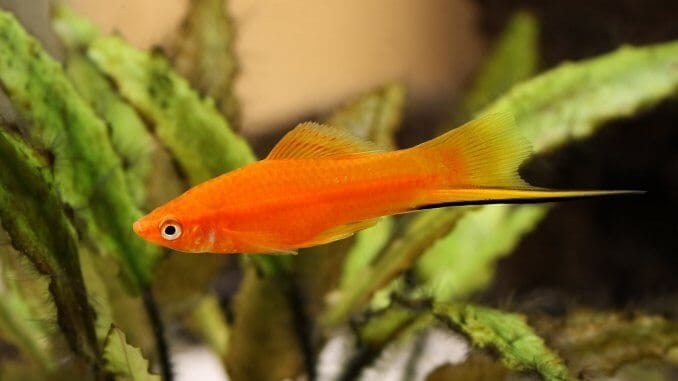
The swordtail fish is a freshwater fish of the Poeciliidae family. Swordtail fish are close cousins to platy fish, and are popular among aquarists because of their attractive coloration, peaceful temperament, and ease of care.
Male swordtail fish have a distinctive sword-like extension on their tail.
TABLE OF CONTENTS
Swordtail Fish Facts & Overview
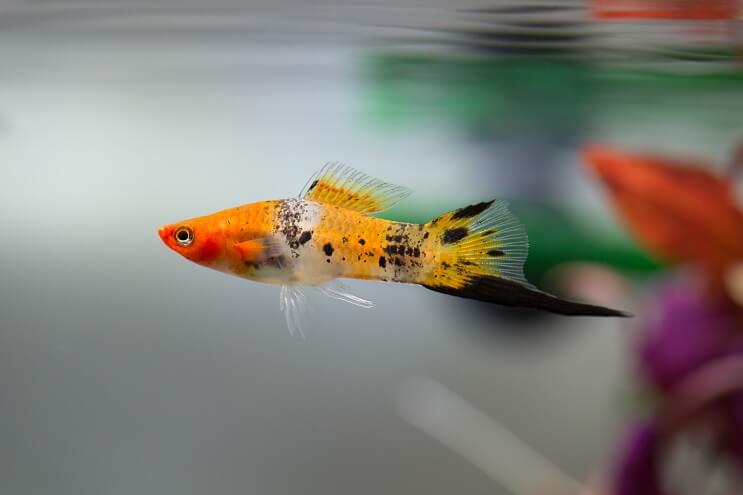
| Scientific name: | Xiphophorus hellerii |
| Common names | Swordtail fish, green swordtail, red swordtail |
| Distribution: | Mexico, Guatemala, Belize, Honduras |
| Size: | Up to 6.3 inches |
| Life expectancy: | 3–5 years |
| Color: | Varies |
| Diet: | Omnivore |
| Temperament: | Peaceful |
| Minimum tank size: | 15 gallons |
| Temperature: | 64–82°F (17–27°C) |
| pH: | 7.0–8.4 |
| Hardness: | 12–30 dGH |
| Care level: | Easy |
| Breeding: | Livebearer |
Origin
The swordtail fish (Xiphophorus hellerii) is native to a range that spans across North and Central America, including Mexico, Guatemala, Belize, and Honduras.
Swordtail fish inhabit fast-flowing rivers and streams, though are sometimes found in ditches, ponds, and springs. These bodies of water are densely vegetated.
Swordtail fish are prolific in both the pet trade and the wild. Captive-bred swordtail fish come in several color morphs and varieties.
Adult Size & Lifespan
The swordtail fish is a medium-sized species. Adult female swordtail fish can reach 6.3 inches in length, while males can grow up to 5.5 inches.
Swordtail fish have an average lifespan of three to five years in captivity. A nutrient-rich diet and ideal water parameters help increase their life expectancy.
Availability
Swordtail fish are popular and available in local pet stores around the world. A swordtail fish costs between $3 and $10, depending on age, location, and color morph.
These fish aren’t schooling fish but do best in small groups. A group of swordtail fish costs around $15. You can find swordtail fish for sale at Aquatic Arts and Arizona Aquatic Gardens.
Buying directly from a reputable breeder ensures the fish are healthy. Avoid fish that appear dull, lethargic, or ragged.
Appearance & Behavior
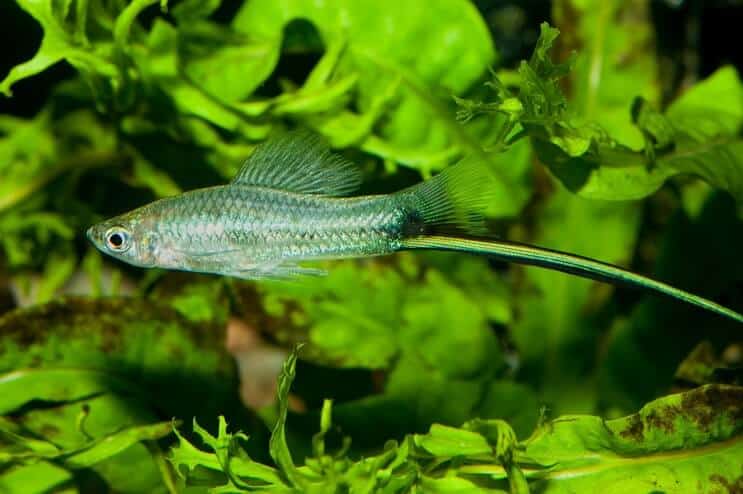
Swordtail fish are medium-sized, colorful fish with streamlined bodies. They are peaceful and make wonderful additions to community tanks.
Colors, Patterns, Fins, and Sex Differences
The swordtail fish gets its name from the male’s sword-like caudal fin. Wild swordtails are green with red and orange lateral stripes on their sides. They are slim and have some speckled markings on their fins.
Swordtail fish are sexually dimorphic. Males have a sword-like extension and gonopodium, which is a modified anal fin that allows the fish to transfer sperm. Females are larger, thicker, and have a more rounded tail edge than males. This species loses its vivid coloration when stressed or ill.
Swordtail fish are colorful and come in a wide range of selectively-bred varieties and color morphs. These include:
- Neon swordtail fish: Bright neon bands across the body. Has an iridescent look, with tints of blue, red, and orange.
- Kohaku swordtail fish: Translucent body with orange and white coloration. Resembles a carp fish. Its eyes are deep red.
- Black swordtail fish: Black body with iridescent blue and green hues. The tail extension is normally yellow.
- Pineapple swordtail fish: Pale yellow body with reddish lines and an iridescent sheen. Its fins are usually deep red or orange in coloration.
- Marigold swordtail fish: Vivid yellow body with fiery-orange tail and fins.
- Wag swordtail fish: A popular variety that gives the fish a deep, black tail.
- Tuxedo swordtail fish: Black patch on the body that makes the swordtail look like it’s wearing a tux. Its tail has a singular black stripe. Several color varieties are available.
- Solar flare twin bar swordtail fish: Shades of red, orange, and yellow. Its colors are soft and blend together. Its tail has black stripes on both sides.
- Hi fin swordtail fish: Fancy variety with extended, flowing fins. Comes in a variety of colors.
- Lyretail swordtail fish: Fancy variety with two sword-like extensions on the tail. Several color morphs are available.
Typical Behavior
Swordtails are peaceful and social fish that enjoy the company of their own kind. These fish spend most of their time in the middle and upper parts of the tank and often form loose groups. They are active swimmers.
Females must outweigh the number of males in the tank. Otherwise, swordtail males become territorial and aggressive.
Swordtail Fish Care & Tank Requirements
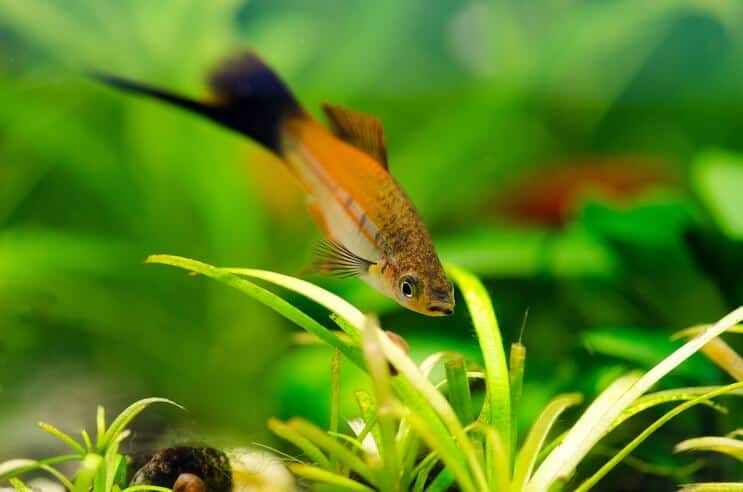
Swordtail fish are easy to care for because of their hardy and docile nature. These fish thrive in groups. A tank that simulates their preferred living conditions helps the fish thrive and stay healthy in captivity.
Swordtail fish are omnivores and require a nutrient-rich diet consisting of pellets, vegetables, flakes, and live and frozen food.
Habitat and Tank Requirements
Swordtail fish are found in a wide range of water conditions in the wild, from clearwater streams to brackish rivers. However, these fish do best in densely-vegetated, moderately hard water.
Tank Conditions
Swordtail fish should be kept in these tank conditions:
| Water type: | Freshwater, with water changes biweekly (25%). Carry out changes weekly if the tank is densely vegetated or heavily populated. Adding a teaspoon of salt per gallon of water can help keep parasites at bay, though isn’t necessary unless there are signs of infection |
| Tank size: | At least 15 gallons for a single swordtail fish. Increase size by 5 gallons per additional fish. An elongated tank shape provides these active fish more room to explore and swim |
| Water temperature: | 64–82°F (17–27°C) |
| Substrate: | Swordtails have no particular substrate preference. These fish rarely spend time at the bottom of the tank. However, a dark, sandy substrate brings out the swordtail fish’s best colors |
| Tank setup: | A biotope tank setup – which replicates the fish’s natural environment – helps swordtails feel at home. Tank should be densely vegetated, but ensure there is still lots of open space. Incorporate caves throughout the tank. Invest in a tank with a secure lid to prevent the swordtail fish from jumping out of the water |
| Acidity: | Keep the pH level between 7.0 and 8.4. Swordtail fish prefer slightly alkaline water |
| Water hardness: | Hardness between 12 to 30 dGH. Swordtail fish are accustomed to moderately hard water |
| Filter: | A filtration system is essential because it keeps the water in peak condition. A filter that generates a moderate flow is ideal for swordtail fish |
| Bubbler: | Not needed |
| Lighting: | Swordtail fish require moderate lighting during the day (12 hours daily). Swordtail fish find direct, harsh lighting stressful |
| Plants: | Add hardy, dense aquatic plants throughout the tank. Good live plant options include anubias nana, dwarf hairgrass, java fern, and scarlet temple |
Perform water changes regularly to prevent stress and illness. Certain swordtail varieties, like hi fins and lyretails, are more sensitive to water fluctuations.
Keep water stable, clean, and at an appropriate pH level. Check nitrate and ammonia levels daily with test kits to ensure water parameters are correct.
Disease
Common freshwater diseases that affect swordtail fish include ICH, cottonmouth, fin rot, and swim bladder disease. Healthy fish exhibit the following traits:
- Bright coloration
- Active swimming behavior
- Good appetite
- Erect fins and tail
- Plump abdomen
Ich
Ich is caused by protozoan parasites and is one of the most common freshwater diseases. A fish with Ich rubs itself against objects in the tank and develops white spots on its fins, gills, and body. Other symptoms include appetite loss and lethargy.
Ich is treatable with medication and by gradually raising the water temperature by a few degrees.
Cottonmouth
Cottonmouth is a highly contagious disease common in livebearing fish. The main symptom is white patches around the swordtail fish’s mouth, gills, or fins. Other symptoms include ragged fins, rapid breathing, and dull coloration.
Treat cottonmouth with antibiotics and by adding salt to the water, with one tablespoon of salt per five gallons. Quarantine affected fish.
Fin Rot
Fin rot is a common disease that causes the fins to fray and rot away. Long-finned swordtail fish varieties are more susceptible to this ailment. Symptoms include tattered fins, inflammation, and dull fin coloration.
Fin rot is treatable with antibiotics and frequent water changes.
Swim Bladder Disease
Swim bladder disease affects the functioning of the fish’s swim bladder. The disorder is caused by constipation, poor water quality, overfeeding, or an infection. The main symptoms include unusual swimming behavior and an inability to stay upright. Many fish float or sink to the bottom of the tank.
To treat swim bladder disease, slowly raise the water temperature up to 80°F and don’t feed the fish for a few days. Then, feed the fish a small pea to aid digestion. Swordtails require medical treatment if an infection is the underlying cause.
Tank Mates
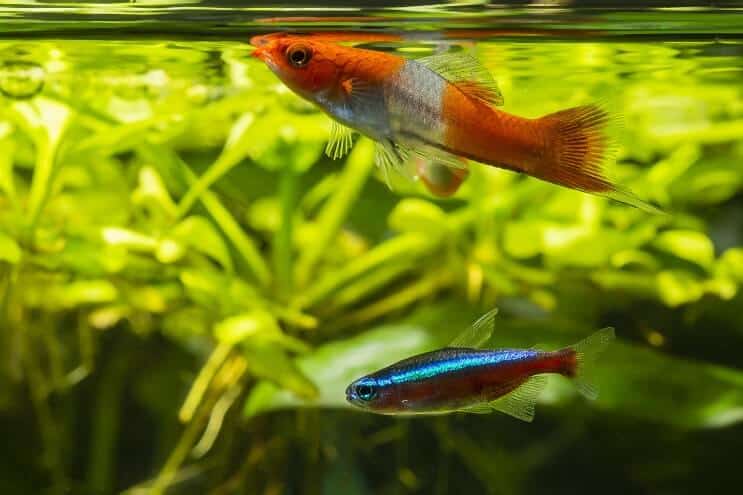
Swordtails are peaceful, social fish that thrive in small groups. While aggression is rare, males are competitive and territorial, so females must always outnumber males (1:3 male to female ratio).
Swordtails shouldn’t be housed together with boisterous species or fin nippers. The best tank mates for swordtails are platy fish. Swordtails are closely related to platies and can even be cross-bred.
Other great tank mates for swordtail fish include:
Diet and Feeding
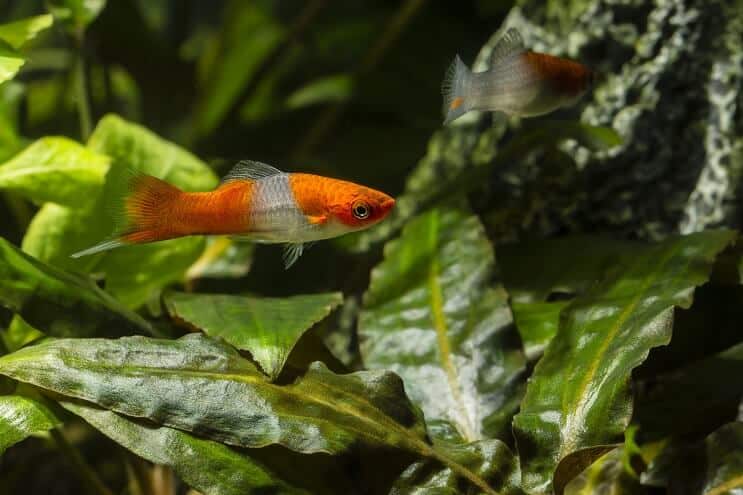
Swordtail fish are omnivores that feed on insects, crustaceans, worms, algae, and plant matter in the wild.
These fish should be fed high-quality flakes and pellets, with the odd algae wafer or vegetable to aid digestion. Occasionally feed them protein-rich live and frozen foods like brine shrimp, daphnia, and bloodworms.
Swordtails need to be fed two to three times per day, given only what they can consume within three minutes. Remove leftovers from the tank immediately to keep the water clean.
Breeding
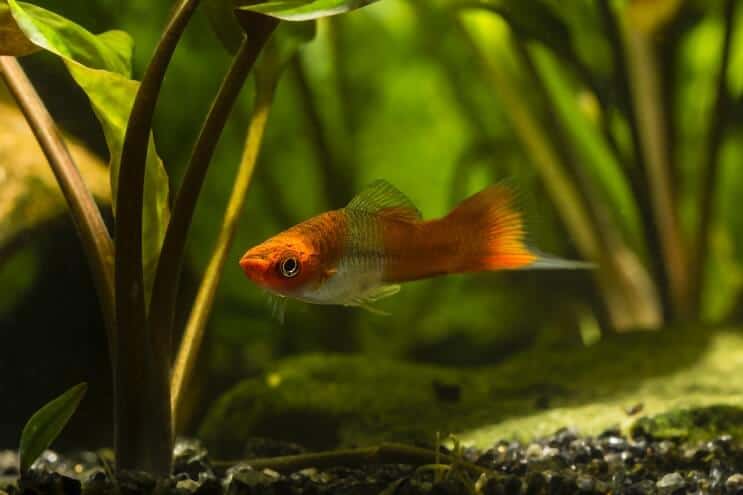
Swordtail fish are livebearers, meaning they give birth to free-swimming fry. In appropriate conditions, they breed readily with little intervention.
Most swordtail fish reach sexual maturity at around three months. Follow these steps to breed swordtail fish:
- Feed the swordtail pair live food and gradually raise the main tank’s water temperature to 80°F.
- Set up a 10-gallon breeding tank with gentle filtration to give the fry the best chances of survival. Create hiding spots for the fry by adding plants throughout the tank.
- During breeding, the male swims beside the female and nips her.
- Move the female to the breeding tank once she shows signs of pregnancy. A pregnant female becomes plump and develops a gravid spot – a black spot near the anal fin. The gestation period lasts several weeks and female swordtail fish produce 80 fry on average.
- Return the female to the main tank once she has given birth. Otherwise, the female may try to eat the fry.
- Fry should be fed three times daily. Give the fry newly-hatched baby brine shrimp or powdered food.
- Move fry into the main tank once they are six weeks old. Ensure the tank has plenty of hiding spots.
Should You Get a Swordtail Fish for Your Aquarium?
Swordtails are colorful and peaceful fish that thrive in community tanks. Get a swordtail if you can accommodate their active swimming habits and have a tank that simulates the fish’s natural environment.
Their tank mates should be docile. Avoid swordtail fish if your tank contains boisterous, large, or fin-nipping species.
Swordtail fish have wonderful personalities and are sure to liven up any tank, as long as their individual needs are met.

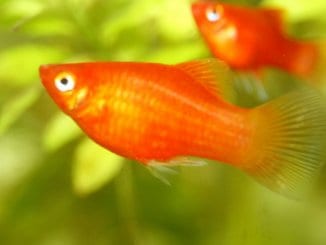
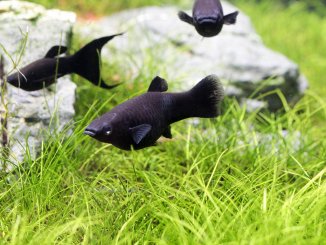
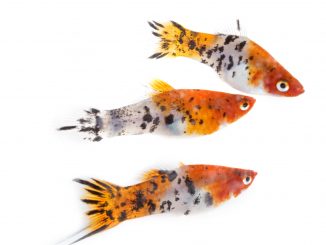
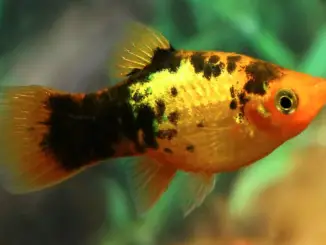
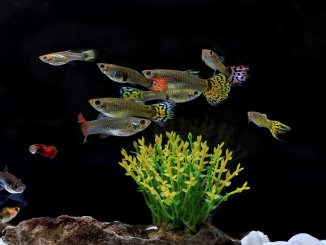
So, I’m considering getting a 30gal and I already have two swordtails and two dojo loaches that are in a ten gallon tank. When I get a 30 gal i would like to have more swords, along with a few other livebearers, a bristlenose pelco, cory cats, and im tryign to decide if i should get gouramis or angelfish or a betta, can someone suggest numbers and i would really like some help to decide between the larger fish.
A 10 gallon is way too small for 2 dojo loaches. The minimum tank size for a dojo loach is 40 gallons.
I have kept swordtail for about 5 years now. Breeding really,when they look like they are getting ready to give birth I move 2 females to a 20L smaller set to give birth. Then move them back and let the fry grow to about 25mm.most of my family and neighbours now have swordtail. Mine live with tetras,bristlenose Pleco and a ruby shark. They all get along fine. It’s only a 100L tank and it’s well planted
Can swordtails live with otocinclus? (otos)